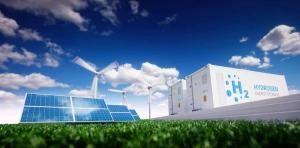Is Hydrogen The Next Big Thing?
Time flies. It’s been six years since we reported on the introduction of Toyota’s hydrogen-powered passenger car, the Murai.
A lot’s happened since 2015, and for most of us, we’d probably assume that the battle between electric and hydrogen-powered vehicles has long been settled in favor of electric.
But the battle between these competing technologies (and the requisite billions of infrastructure required to back them up) is heating up again.
We’re on the cusp of war to establish the dominant energy paradigm for the next 50 years.
And it will prove to be a far bigger rivalry than some of the most epic technology battles of the past, including the video player competition between Sony’s Betamax and JVC’s VHS tape format or Thomas Edison’s epic fight for a direct current electric power grid — which ultimately lost out to Westinghouse’s alternating-current system.
The question before us is whether we will have a future power-grid primarily based on solar and wind derived electric power, stored in massive batteries, or if we will move to an infrastructure that chiefly relies on hydrogen to store energy, heat / cool our homes, and power our vehicles (including airplanes) — or will we see a mixed solution that elements aspects from each of these rival competing systems.
Billions of dollars are on the line, and the temperature of the planet may hang in the balance, which makes us think of Benjamin Franklin’s apocryphal quote after signing the Declaration of Independence.
“We must all hang together, or … we shall all hang separately.” — Benjamin Franklin
Billions To Be Invested Worldwide To Create A New Hydrogen Economy
So where does hydrogen fit in the future plans of the world’s energy markets?
If we look at proposed plans around the world, hydrogen figures to be a big player.
With the recent climate disasters in mind, many of the world’s political leaders are acting now to create investment plans for hydrogen-based energy infrastructure to replace our current system that relies primarily on burning fossil fuels.
Let’s take a survey of the current plans.
▪ United States
The US Department of Energy has created a comprehensive plan to transform the American energy market based on a solar and hydrogen infrastructure.
President Biden is on board and has been touting green energy infrastructure plans as a way to create new high-paying jobs and help the country transition to renewables.
The administration’s latest goal is to derive 50% of our electricity from solar by 2050 and to dramatically ramp up solar panel production in the USA. But while solar is grabbing the headlines, hydrogen is also a major component of the administration’s agenda.
The question is how to pay for it.
The bi-partisan “Infrastructure Act” that passed the Senate calls for a series of demonstration projects, including $8 billion to fund regional hydrogen “hubs”(for producing, transporting, and storying hydrogen, including developing new carbon capture technology) and calls for a National Clean Hydrogen Strategy and Roadmap and Clean Hydrogen Manufacturing Initiative.
Will there be more funding?
That question hangs in the balance. The “Infrastructure Act” has only passed the Senate, while the House crafts its own $3.5 trillion budget that it hopes to pass via budget reconciliation procedure. One or both could pass, but much remains to be seen. We likely won’t know what will be funded and what gets chopped until mid-October.
▪ Canada
Like the US, Canada is a fossil fuel energy producer, so its new plans for a future hydrogen-based energy infrastructure represents a major policy shift.
As it stands, Trudeau’s Liberal government proposes that Canada could deliver 30% of its energy requirements via hydrogen, and it claims that this would create a $50 billion domestic hydrogen sector with over 350,000 high-paying jobs.
However, a snap Federal election will take place on September 20, 2021, so if the Conservatives win, all bets are off as political power shifts to the oil and gas rich western provinces.
▪ European Union
What about the EU?
The EU is following a similar path to the US in that they are using Coronavirus economic recovery funds to pay for new clean energy infrastructure as part of its goal to be carbon neutral across the bloc by 2050.
The initial plan called for spending €470 billion on hydrogen infrastructure over the next 30 years, with the hopes of generating up to 10 million tons of renewable hydrogen annually (which would require 40 GW of electrolyzers in the EU).
To bootstrap these goals, the EU has established a public-private partnership, the Fuel Cells and Hydrogen Joint Undertaking (FCH JU), to fund the development of clean hydrogen technology. A related investment arm, The European Clean Hydrogen Alliance, is working to coordinate government and private investment.
▪ Germany
Within the EU, Germany has pinned its hopes on being a leading hydrogen technology exporter and also use hydrogen production or for its large chemical industry.
The German government has produced its own national hydrogen strategy (available in German) – but English readers will also be interested in the government’s business opportunities white paper, which outlines the thinking behind their hydrogen initiatives.
Germany is also home to what will be Europe’s largest Polymer electrolyte membrane (PEM) hydrogen electrolyzer to date, the Shell plant on the south side of Cologne. According to Shell, the plant will be able to produce 100 megawatts – a great accomplishment, but some caution is required as this only represents 0.25 percent of the EU’s ultimate goal of 40GW.
▪ United Kingdom
The United Kingdom has been polishing up its environmental credentials leading up to hosting United Nation’s COP 26 climate meeting on November 1.
The overarching goal is for the UK to achieve net-zero by 2050. New this year is the adoption of a “Sixth Carbon Budget” to reduce UK greenhouse gas emissions by almost 80% by 2035 compared to 1990 levels.
In a BBC interview, the UK’s Business Minister Lord Callanan revealed details of the August update to the UK Hydrogen Strategy, which now sets a goal of producing 5GW of clean hydrogen energy by 2030. This is about 12.5% of the EU goal of 40GW but is promised in a much shorter timeframe, e.g. 9 versus 30 years.
▪ Australia
Australia issued its most recent national hydrogen strategy in 2019.
The Australian government’s focus centers around becoming a leading source of hydrogen production for the world’s energy market as well as a low-emissions tech leader.
To support that effort, the government has budgeted $539.2 million in new clean hydrogen, carbon capture, use and storage (CCS/CCUS) projects.
As proof of its ambitions to become a clean energy provider, Australia can point to its privately developed Sun Cable system, an audacious plan to build the world’s largest solar farm (at nearly 58 square miles, it will be 10 square miles bigger than the city of San Francisco) which will produce 10GW of electricity to be sent via overland and underwater cables to Singapore.
What Is Driving The Investment In A Future Hydrogen-Based Economy?
Hydrogen offers several unique benefits over other energy sources.
Here are some of the key factors that are attracting investment in a future hydrogen-based economy
Read full article here @formaspace








Your point of view caught my eye and was very interesting. Thanks. I have a question for you.